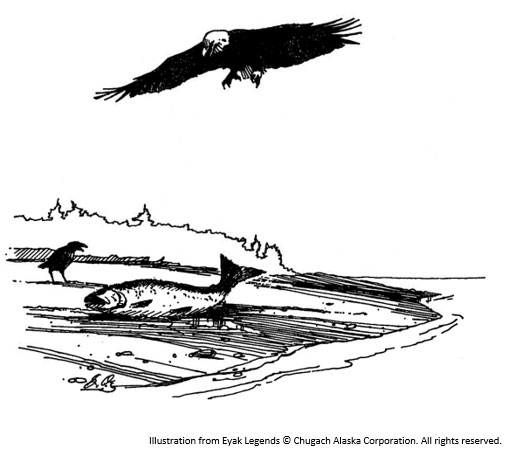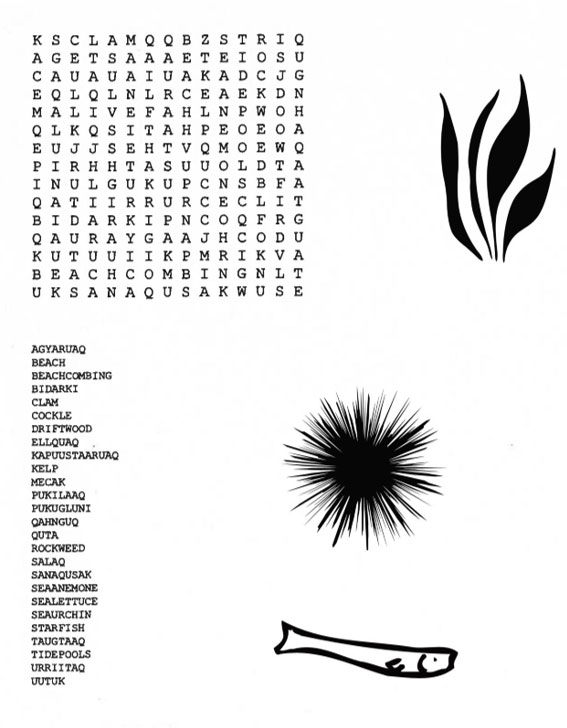Unit 2: Beaches and Tidal Zones
There is a great diversity of habitats, organisms and cultures throughout Alaska and in the Chugach Region.
Lesson Plan 2 “Beach Treasures – Food on The Beach”

Summary: Students will investigate the variety of inter tidal organisms found on the tidal zone. Students will also examine some of the ways that the Chugach tribes use materials gathered from the beach for various purposes.
Suggested Grade Level:
K-4, 5-8, 9-12
Time required:
Five class periods of 45 minutes
Materials needed:
• Species identification field guides
• Buckets/basins
• Rubber gloves
• Hand magnifying lens
• Camera
• Rulers (measure organisms)
• Science journal
• Pencils
• Construction paper
• Markers, colored pencils, art materials
Learning objectives:
• Students will identify and name inter-tidal organisms in the Gulf of Alaska, Chugach Region.
• Students will identify the invertebrates: Mollusks, Echinoderms, and Crustaceans.
• Students will tell how the Chugach tribes use the different inter-tidal organisms.
• Students will learn about changes in the inter-tidal area of the Chugach Region from the Elders.
• Students will describe the life cycles of three of the inter-tidal organisms they find.
Vocabulary introduced:
Tides, Tide pools, Intertidal ecosystems, Beach food, Coastal ecosystems, Biodiversity, Harvest, Chiton/bidarki, Sea urchin, Sea weed, Beach grass
National Science Education Standards:
Life Science
Content Standard C: As a result of their activities in grades K-4, all students should develop understanding of the following:
• The characteristics of organisms
• Life cycles of organisms
• Organisms and environments
Content Standard C: As a result of their activities in grades 5-8, all students should develop understanding of the following:
• Structure and function in living systems
• Reproduction and heredity
• Regulation and behavior
• Populations and ecosystems
• Diversity and adaptations of organisms
Content Standard C: As a result of their activities in grades 9-12, all students should develop understanding of the following:
• The cell
• Molecular bases of heredity
• Biological evolution
• Interdependence of organisms
• Matter, energy, and organization in living systems
• Behavior of organisms
Alaska State Standards:
Concepts of Life Science
A student should understand and be able to apply the concepts, models, theories, facts, evidence, systems, and processes of life science.
A student who meets the content standard should:
• Develop an understanding of how science explains changes in life forms over time, including genetics, heredity, the process of natural selection, and biological evolution;
• Develop an understanding of the structure, function, behavior, development, life cycles, and diversity of living organisms; and
• Develop an understanding that all organisms are linked to each other and their physical environments through the transfer of transformation of matter and energy.
Background Information:
The teacher will have to take notice of the natural environment of the school area, especially the coastal area for field trips. Also know the names of the marine life, by both the western and Indigenous names.
Find out if there are local beliefs regarding the fish, mammals, and sea plants or that has been told to share with the students.
Meet the elders/cultural bearers prior to their visit to the classroom so they understand what you would like them to share and let them become familiar with the classroom.
Have water or tea for the elder/cultural bearer to drink during their visit to the classroom.
Review social expectations with the class prior to the guest speaker (sitting respectfully listening to stories, waiting until the speaker has finished talking before asking questions, offering assistance/escorting when the speaker is leaving).
Have a small gift of thanks for the guest (something made by the class, or a card, and follow with a letter from the students).
Local Story
|
RAVEN AND THE OWNER OF THE HIGH WATER Paul Eliah (from the Chugach Legends, 1984, p.88)
There was an old woman. She was the owner of the High Water. Raven was walking along the beach, when he found a sea urchin, all dried up and empty. Then he saw a smoke house and went in. He rubbed his hands and said: “I ate so many sea urchins my hands are cold.” The old woman answered: “That is strange, I do not miss any tides. I am always walking on the beach, and I have not found a sea urchin yet.” Said Raven: “You think I am lying to you?” Then he took the sea urchin from under his wing and rubbed it on her backside. She yelled: “Aiya, aiya! You were not lying, you found the sea urchins!” |
 Listen to the Audio version of the story recorded with Herman Moonin.
Listen to the Audio version of the story recorded with Herman Moonin.
Elders Observations
“We used to see green sea urchins all over Nanwalek Reef in the early 1940s. By the late 50’s sea urchins were mostly gone. Sea cucumbers were eaten by the elders too, we liked them better than bidarkis because they were softer… not much eaten now.” (John Moonin, Elder, Port Graham)
“There were more urchins when I was a kid. The urchins were the first to go, then crab and clams. Bidarkis, they’re the most recent change, now they're declining.”
(Quotes from Imam Cimiuca, 2010.)
Resources: Alutiiq Words
Beach related terms
| Beach | quta |
| Beachcombing | pukugluni |
| Tide pools | mecak, nanualiwat |
| Tide comes in | tung’irluni |
| Tide goes out | kenlluni |
| Low tide | ken’aq |
| High tide | tung’iq |
| Sea anemone | sanaqusak |
| Sea urchin | uutuk |
| Star fish | agyaruaq |
| Clam (in general) | salaq |
| Blue nose clam/Red neck clam | kawilnguq |
| Butter clam | mamaayaq |
| Razor clam | cingtaataq |
| Chiton/bidarki | urriitaq |
| Cockle | taugtaaq |
| Kelp | qahnguq |
| Bull kelp/ Giant kelp | qahnguq (entire plant) |
| nuakataq (stem) | |
| nasquluk (bulb) | |
| Gunshot kelp | iituk |
| Rockweed | ellquaq |
| Sea lettuce | kapuustaaruaq |
| Go and get seafood at low tide | aciwarluni |
| Dig | lagluni |
| Food | neqa, neqet |
| Driftwood | pukilaaq |
| Coast | llur’aluni |
| Bucket | wiitruuq |
| Sand flea | qumitgaq |
(From Nanwalegmiut Paluwigmiut-llu Nupugnerit – Conversational Alutiiq Dictionary, Kenai Peninsula Alutiiq by Jeff Leer, 1978 and English Bay and Port Graham Alutiiq Plantlore – An Ethnobotany of the Peoples of English Bay and Port Graham, Kenai Peninsula, Alaska by Priscilla N. Russell/Chugach Heritage Foundation/Pratt Museum/Alaska Native Plant Society, 1991.)
Resources: Literature, audio, video, other curriculum
Literature
• Baird, Steve. Map of the Lower Kachemak Bay (in Imam Cimiuca – Our Changing Sea). 2010.
• Center for Alaskan Coastal Studies. Intertidal Field Atlas. 1999. Available online: http://www.akcoastalstudies.org/data/attachments/Intertidal_Field_Atlas.pdf
• Cook Inlet Regional Citizens Advisory Council: Seaweeds of Alaska. http://www.seaweedsofalaska.com/
• Fowler, Allan. Life in A Tide Pool. 1997.
• Garza, Dolly. Surviving on the Foods and Water from Alaska’s Southern Shores. 2007.
• Garza, Dolly. Common Edible Seaweeds in the Gulf of Alaska. 2005.
• Hunter, Anne. What’s In the Tide Pool? 2000.
• L’Hommedieu, Arthur Jon. Ocean Tide Pool. 1998.
• Russo, Ron. Pacific Intertidal Life: A Guide to Organisms of Rocky Reefs and Tide Pools of the Pacific Coast. 1981.
• Salomon, Huntington & Tanape. Imam Cimiuca – Our Changing Sea. 2010.
• Silverstein, Virginia. Life in A Tide Pool. 1990.
• Wertheim Rosenfeld, Anne. The Intertidal Wilderness: A Photographic Journey through Pacific Coast Tidepools. 2002.
Videos
• Chugachmiut. Sugpiat Lucít – The Ways of the Sugpiaq. 2000. http://www.iqsak.org/images/video/SugpiagLucit.wmv
• Byers, Kurt & Sigman, Marilyn. Life on the Beach: Among Friends and Anemones. 2004. http://seagrant.uaf.edu/bookstore/pubs/M-29.html (buy online) with a teacher’s guide http://seagrant.uaf.edu/bookstore/pubs/M-29teacherguide.pdf
• Tide Pool Video: https://www.youtube.com/watch?v=ZkULAD8gJT0
Other curriculum
• Culture, History and Heritage of the Chugachmiut, Level 2, Grades 1-3, Our Resources, Subsistence, Exploring the Shoreline, p. 134 – 139.
SmartBoard
• Life in a Tide Pool. This lesson focuses on the animals living in a tide pool. (1-2) http://exchange.smarttech.com/details.html?id=3a389119-b3bb-4b71-8732-b7b30f251035
• Who Am I? Ocean Animals. Students (2) identify ocean animal by looking at a picture and selection a response. A worksheet is included and an attached tide pool tile game. http://exchange.smarttech.com/details.html?id=c68074ad-5af3-4a06-8215-343a6443a8cf
Procedure:
Engagement
• Ask students to share their knowledge of Chugach cultural relationships with beaches and tides.
• There is an Alutiiq saying “When the tide goes out, the table is set”. Ask the students what this means.
• Show historic photos/items of kayaks, baskets and fur items made from skin, wood, beach grass, and ask students to tell what materials they are made of.
• Ask students what type of plants and animals they think the Alutiiq used in the old days and how they think they were used.
• Have students locate local beaches and coastline on maps and aerial photos.
• Ask students to prepare a coastal/tidal species list for identification purposes.
Exploration
• Take students on a visit of a beach on low tide. Allow students 15 minutes to explore the various intertidal organisms in the area and sketch drawings of them in their journals.
• Give students magnifying glasses and other examination tools to examine various parts of intertidal organisms.
• Provide students with material to create a game or a toy and give them ten minutes to create it. Allow them to share their creations with the class.
• Show students example of an Alutiiq game after students have created a toy or game of their own and have them compare. Allow them to make their own Alutiiq game.
• Allow students a few minutes to reflect on the activity in their journal.
• Measure the tides with: see Alan Dick’s “Measuring the Tide” from ANKN.
Explanation
• Show posters and diagrams of tidal ecosystems and discuss.
• Introduce the vocabulary terms “tides”, “tidal pool”, “diversity” and “biodiversity” and define for students.
• Have students identify the name of the organism observed on the field trip, along with its use by local tribes. Have students use the categories of Food, Medicine, Tools, and Shelter for the various uses of organisms. Journals will be used to draw and label pictures.
• Have students share important concepts and observations that they have learned about the relationship that Alaska Natives have with inter tidal organisms with members of their class.
• A discussion about the important relationship that tribes have with inter tidal organisms will help to re-enforce important concepts.
• Invite a tribal natural resource manager to discuss the importance of managing and protecting coastal areas.
• Discuss the impacts of the loss of these areas on tribal culture.
• Invite a tribal elder to talk to the students about the importance of beaches to tribal ways of life.
• Also invite the elder to share a craft using inter tidal organisms and encourage storytelling.
• With the help of the elder, fill out the seasonal species chart – what organisms can be harvested in the region in what season? Name the species in the chart with their Sugcestun, English and Latin names.
Elaboration
• Students compare and contrast the organisms observed in the tidal pools.
• Students chose one of the organisms used by the Chugach tribe to use in the traditional way and share this with the class.
• Students justify why they should have subsistence use of the tidal pools.
• Tell how the region’s organisms have changed since the Exxon Valdez spill.
Evaluation
• Observe student participation as they are discussing the importance of coasts and tides amongst themselves.
• Analyze student journals for comprehension of the lesson and identification of the organisms.
• Students create a storyboard of how the Chugach tribes use either one; Mollusks, Echinoderms, or Crustaceans, from harvesting to final product.
• Rewrite the stories told by the Elders about the changes in the inter-tidal area of the Chugach Region.
Follow Up Activities:
• Fill out the seasonal species harvest table with community elders and the students. Find out the local, common and scientific names of the species.
• Compare and Contrast harvesting of mollusks, echinoderms and crustaceans by the Chugach tribes from the past, prior to Western contact to today.
• Clean up local beaches of trash. Invite the whole community to participate in this.
• Create an art collage with the students from objects found on the beach. Identify the materials whether they are manmade or natural.
• Play the “Beach treasures” word search (you can find the activity sheet in the Document Library and print them out, or use SmartBoard).
BEACH TREASURES WORD SEARCH

